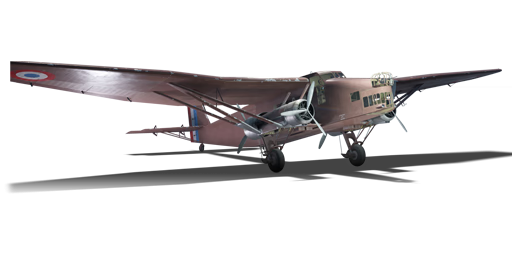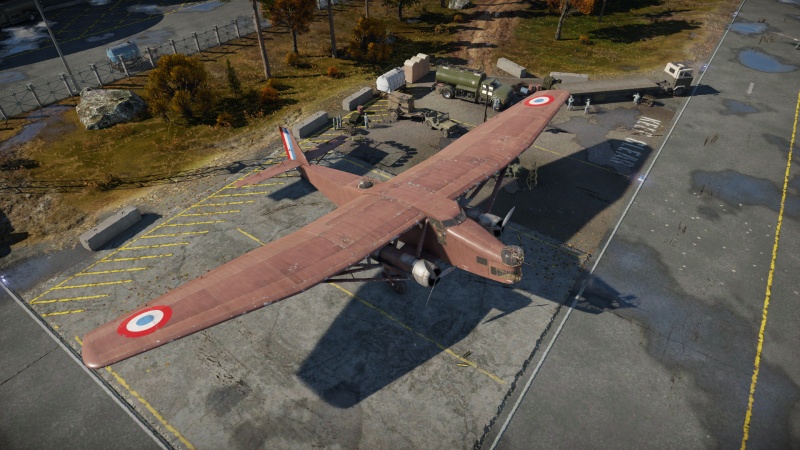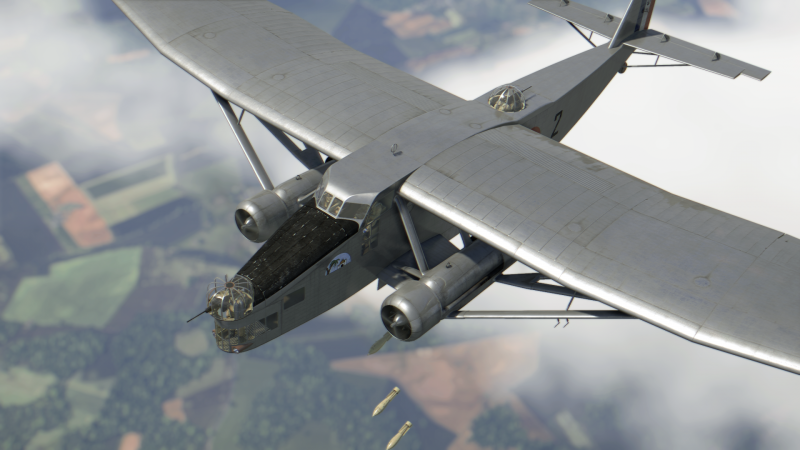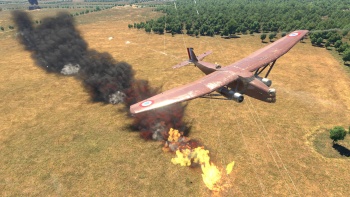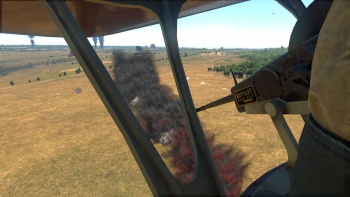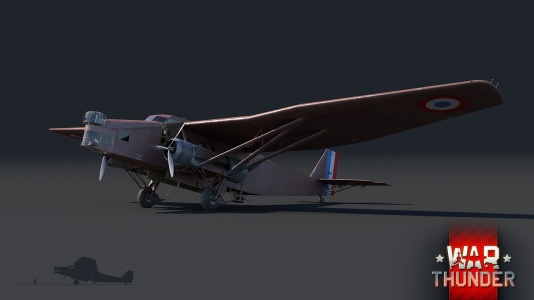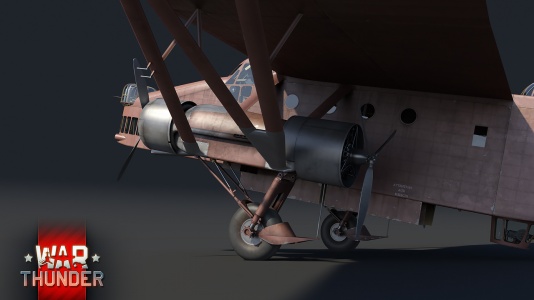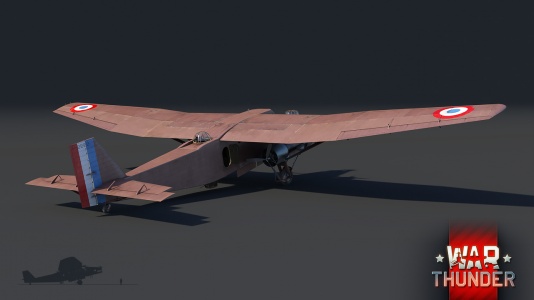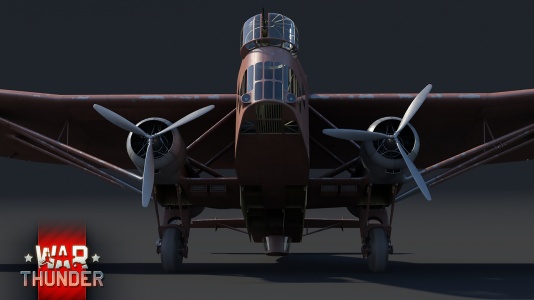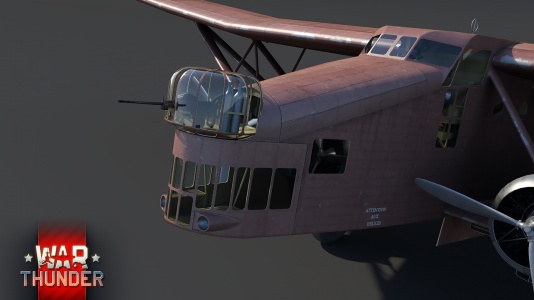F.222.2
Contents
Description
The F.222.2 is a rank I French bomber with a battle rating of 1.7 (AB), 2.3 (RB), and 1.3 (SB). It was introduced in Update 1.73 "Vive la France".
The Farman F.222.2 is the first French bomber in the tech tree lineup. Most nations in War Thunder start with small to medium two-engined bombers which can drop a few bombs, though the Italians step it up with the three-engined S.81 bomber; however, this does not come close to the French. Showing up to dominate the early ground-pounding scene, the F.222.2 is the biggest, heaviest, least manoeuvrable, and hardest hitting bomber early in the game, at a low battle rating. This massive bomber's empty weight is more substantial than the Italian S.81's loaded weight.
The F.222.2 features a high wing setup with four radial engines set up in a push-pull configuration. This engine setup allows the pulling engines to turbocharge the wind passing through the pushing engines adding needed horsepower. This also, unfortunately, concentrates the engines into close quarters, making it easier for enemy fighters to hit them. While this aircraft has the potential to soak up a lot of 7.5 mm bullets (even some 20 mm), the wings potentially provide an Achilles heel of the aircraft. Each wing contains eight massive fuel tanks which do not self-seal when hit, and they are prone to catch on fire. A burning F.222.2 will not last long before structural fatigue sets in and the wings buckle.
With a huge target to fend off incoming fighters, the F.222.2 is not without any defences. This bomber is protected by three turrets: one ventral, one dorsal, and one in the nose. All three turrets feature a single Darne Mle 33 7.5 mm machine gun. It may not seem like much, though against small fighter aircraft which lack any armour, chances are the gunners will rupture the fighter's engine, oil coolers, water coolers, fuel tanks, or even incapacitate the pilot leading to an aerial victory. Fighters looking for a fast and "free-kill" when going after the F.222.2 should think twice before just rumbling up on the bomber's doorstep, as they may find themselves on a one-way trip to the ground in a heap.
The massive F.222.2 has one purpose, and that is to drop bombs, lots of bombs! This massive aircraft initially carries 52 x 50 kg bombs. Later upgrades will include 100 kg, 200 kg, and 500 kg bombs, maxing the payload out at 2,700 kg! Payloads this size can take out columns of vehicles and, even in up-tiered situations, can do massive damage against enemy bases. This bomber works best at lower altitudes such as between 100 and 500 m, though this beast is nimble enough to bomb targets from as low as 50 m off of the deck. This huge bomber can be a bit frustrating at first, but as modules are unlocked and added, the aircraft can take more damage. It can be surprising how long it survives even though it is full of holes and is trailing smoke from several of its surfaces.
General info
Flight performance
| Characteristics | Max Speed (km/h at 3,400 m) |
Max altitude (metres) |
Turn time (seconds) |
Rate of climb (metres/second) |
Take-off run (metres) | |||
|---|---|---|---|---|---|---|---|---|
| AB | RB | AB | RB | AB | RB | |||
| Stock | 348 | 333 | 6200 | 34.2 | 35.2 | 4.1 | 4.1 | 750 |
| Upgraded | 383 | 366 | 31.9 | 33.0 | 9.3 | 6.4 | ||
Details
| Features | ||||
|---|---|---|---|---|
| Combat flaps | Take-off flaps | Landing flaps | Air brakes | Arrestor gear |
| X | X | X | X | X |
| Limits | ||||||
|---|---|---|---|---|---|---|
| Wings (km/h) | Gear (km/h) | Flaps (km/h) | Max Static G | |||
| Combat | Take-off | Landing | + | - | ||
| 0 | 450 | N/A | N/A | N/A | ~5 | ~3 |
| Optimal velocities (km/h) | |||
|---|---|---|---|
| Ailerons | Rudder | Elevators | Radiator |
| < 250 | < 250 | < 300 | > 210 |
Survivability and armour
- No armour plating
- No armour glazing
- Vulnerable fuel tanks in the wings
- Engines highly sensitive to damage
- Huge aircraft, slow and large target
Modifications and economy
Armaments
Suspended armament
The F.222.2 can be outfitted with the following ordnance:
- 52 x 50 kg G.A. MMN. 50 bombs (2,600 kg total)
- 5 x 200 kg No.1 bombs + 7 x 100 kg No.1 bombs (1,700 kg total)
- 4 x 500 kg No.2 bombs (2,000 kg total)
- 10 x 200 kg No.1 bombs + 7 x 100 kg No.1 bombs (2,700 kg total)
The game style will change depending on the type of bomb payload chosen. For usage on early maps without bases, the 52 G.A.M.Mn bombs will be the payload of choice. These small bombs used from a low altitude provide a scatter effect, where they can be dropped in a column, allowing for convoys of vehicles or multiple cluster sites of artillery to be bombed in one run. Utilising the 50 kg bombs from higher altitudes against vehicles is discouraged, as they tend to scatter out of the effective explosive range of the bombs by the time they get to the ground. Low bombing runs against vehicles hits them before they have time to scatter.
Conversely, the larger bombs tend to be less effective against small vehicle targets, especially from higher altitudes which give them time to scatter and move out of the effective explosive range. The 100 kg, 200 kg, and 500 kg bombs are very effective against stationary and hardened targets such as anti-aircraft artillery sites, pillboxes, and bases. Base bombing is very effective from higher altitudes, especially if there is fighter escort which will help provide the bomber time to get to the site and drop its payload.
Defensive armament
The F.222.2 is defended by:
- 1 x 7.5 mm MAC 1934 machine gun, nose turret (1,000 rpg)
- 1 x 7.5 mm MAC 1934 machine gun, dorsal turret (720 rpg)
- 1 x 7.5 mm MAC 1934 machine gun, ventral turret (720 rpg)
The F.222.2 has decent turret coverage when it comes to defences. With one turret in the nose of the aircraft and the other two located at the dorsal and ventral positions, the bomber is capable of defending itself from attacks from multiple angles. Early fighters typically do not have any armour protection. As such, if they approach from the rear of the F.222.2, they are likely to take critical damage. Be aware of fighters approaching from the side, since there are more blind spots from this angle. From here, they will be targeting either the engines or the wings which contain huge fuel tanks. Do not be afraid to chase or saddle up next to enemy fighters in order to give the turret gunners a chance to unload on the fighters and potentially score an aerial victory.
Usage in battles
The F.222.2 is a heavy-hitting bomber with okay manoeuvrability at low altitude and low airspeed and can carry a staggering 52x50 kg bombs while still in stock configuration. Combined with its frequent presence in Ground Strike matches with only light vehicles, it will make short work of any (or even all) groups of armoured cars and SPAA it crosses paths with, in addition to destroying an opposing team's entire complement of AAA and artillery in short order.
Additionally, the ability to carry larger bomb loads later in its upgrade tree turns it into an exceptionally capable base killer, often time wiping out bases solo without sacrificing its heavy-hitting power against armoured columns. With some skill (and an escort from friendly fighters), the F.222.2 can wipe out an entire column of medium tank AI targets in a single pass, with enough firepower left over to seriously cripple another column.
It is important to match the altitude flown with the payload type chosen as lower altitudes (100 - 500 m or even lower) when utilising the 50 kg bombs against moving targets, whereas higher altitudes are preferred when utilising larger ordnance against stationary targets. On maps where controlling an airfield is key, do not be afraid to "carpet bomb" the runway to prevent enemy aircraft from taking over the airfield or out-right destroy those which have landed. Be aware of friendly aircraft which may also be on the runway as the bombs do not discriminate who they damage/destroy.
Manual Engine Control
| MEC elements | ||||||
|---|---|---|---|---|---|---|
| Mixer | Pitch | Radiator | Supercharger | Turbocharger | ||
| Oil | Water | Type | ||||
| Controllable | Not controllable Not auto controlled |
Not controllable Not auto controlled |
Not controllable Not auto controlled |
Combined | Not controllable 1 gear |
Not controllable |
Pros and cons
Pros:
- Impressive bomb load
- Very stable flight in simulator battles
- Different bomb options make this bomber very versatile
- Fuselage can absorb a lot of damage
- Once at altitude, it can be difficult to reach for reserve planes
- Can keep flying even after it loses 2 engines
- Can easily destroy bases and airfields in air RB
- Good visibility in in simulator battles
Cons:
- Extremely slow and very heavy
- Engines are very vulnerable to enemy weapons
- Slow speed, heavyweight, and no takeoff flaps make taking off when fully loaded very difficult
- Long take-off distance
- Vulnerable to fast climbing, well-armed aircraft like the MiG-3
- Armament is slightly underwhelming for such a large aircraft
History
Farman Aviation Works began working on the F.220 bomber design in 1925. This aircraft was based on a successful earlier design of the F.211 which was a parasol wing, four-engine monoplane utilising tractor and pusher engines. While the F.211 never entered production, it served as a base for the F.220 to be designed and built from. The first successful flight of the F.220 happened on 26 May 1932.
The F.220 was a success in of itself, however, Farman made several modifications to improve the design which included a new vertical stabilizer, rebuilding the nose and ventral turret to fully enclose them and upgrading the old V-engines to new radial versions. After these modifications, the new version of the F.220 made its maiden flight in 1933.
In 1936, another variant, the F.222 first flew and this bomber incorporated retractable landing gear which reduced drag and was not available on earlier versions. A total of twenty-four aircraft of this version where produced and began service in Armee de l'Air in 1937 and was tasked with performing night bombings raids over Germany in May and June of 1940.
The F.222.2 bomber which is featured in the game had a redesigned nose and changed out the engines from Gnome-Rhône 14Kdrs engines to Gnome-Rhône 14N-11 engines.
The later F.223 which came after the F.222 saw significant changes, not only to name as it became NC.223 after Farman was absorbed into Société Nationale de Constructions Aéronautiques du Centre (SNCAC) which was the nationalisation of both Farman Aviation Works and Hanriot in 1936. The aircraft's tail section was reworked and went from a single vertical stabilizer to a twin-stabilizer setup and the fuselage was refined to be more aerodynamic. Another upgrade came in the form of changes to the ventral and dorsal turret weapons. The Mle 33 7.5 mm machine guns were replaced with the more powerful H.S. 404 20 mm autocannons.
On 7 June 1940, a variant NC 223.4 of the French Naval Aviation was the first allied bomber to fly into Germany and bomb Berlin, the flight dropped eight 250 kg and 80 x 10 kg bombs on Germany's capital. While the ordnance was not much, the psychological impact was the goal and the raid was reproduced three days later. NC 223 bombers continued to serve in bombing roles until June 1940 when they were transferred to North Africa to fulfil the role of transport aircraft.
Media
- Skins
- Images
See also
Links to the articles on the War Thunder Wiki that you think will be useful for the reader, for example:
- reference to the series of the aircraft;
- links to approximate analogues of other nations and research trees.
External links
| Farman Aviation Works (Avions Farman) | |
|---|---|
| Bombers | F.222.2 · N.C.223.3* |
| * Originally the F.223, it was redesignated NC.223 when Farman Aviation was absorbed into the nationalized SNCAC | |
| France bombers | |
|---|---|
| Farman | F.222.2 · N.C.223.3 |
| Latécoère | Late 298D |
| Potez | Potez 633 |
| Liore et Olivier | LeO 451 early · LeO 451 late |
| Bloch | M.B.174A-3 · M.B.162 · M.B.175T |
| American | V-156-F · Martin 167-A3 · ▄A-35B · ▄SB2C-5 · B-26C · ▄PBY-5A Late · ▄PB4Y-2 |
| British | Lancaster MR.7 |


